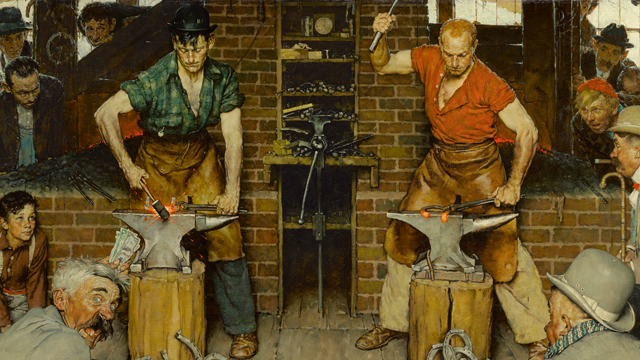[ad_1]

Norman Rockwell’s Blacksmith Boy (1940), which sold at Sotheby’s today for a hammer of $7 million, its low estimate.
COURTESY SOTHEBY’S
On Wednesday morning at Sotheby’s in New York, one of the Berkshire Museum’s Norman Rockwell paintings, Blacksmith Boy (1940), sold for its low estimate of $7 million to a bidder on the phone with Elizabeth Goldberg, the auction house’s chairman of American art.
That was the highest price realized by the museum as part of a controversial sell-off of 13 works over the past few couple weeks at Sotheby’s, which also included a Francis Picabia watercolor and an Alexander Calder mobile that hammered for a below-estimate $1 million last week (in a sale to Sandy Rower, the grandson of Calder who leads the Calder Foundation).
After the offering of 13 pieces (two of which failed to sell) and a private deal through which the Lucas Museum in Los Angeles bought Rockwell’s Shuffleton’s Barbershop (1950) for an undisclosed sum, the museum in Pittsfield, Massachusetts, has now brought in $42 million, well short of the $55 million the institution said it hopes to raise in an effort to build an endowment and close a budget deficit that leadership has said risks shuttering the museum in coming years.
“Considering the unpredictable nature of the art market, we are disappointed but not surprised to fall short of our expected goal by close to $13 million,” Elizabeth “Buzz” McGraw, the president of the museum’s board, said in a statement, while adding, “These auctions move the Berkshire Museum . . . forward by providing resources needed to secure the museum’s future.”
Since the plan was announced last summer, the Berkshire Museum has been hammered by professional groups who argue that the sell-off will dissuade future donors as well as opponents who have staged protests outside the auction house in advance of some of the sales.
Under the terms of an agreement struck with the Massachusetts Attorney General and approved by the state’s highest court, the museum has the option of selling up to 40 works—in three separate tranches—in order to reach the stated $55 million mark, meaning that 26 more works could still potentially be sold. (And the two works that passed could be offered again.)
“We will take time now to consider how we will proceed, through possible auction and private sale, to gain the additional resources needed,” McGraw said. “We are eager to continue the important work of planning for the future.”
[ad_2]
Source link
